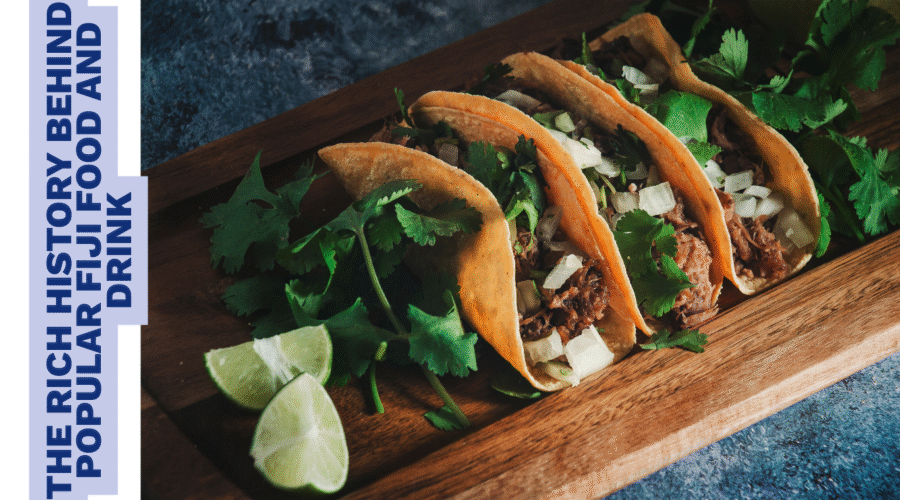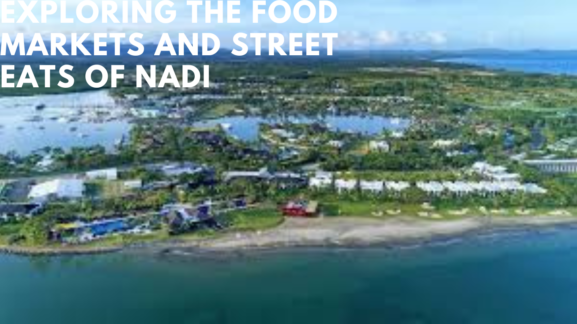The Rich History behind Popular Fiji Food and Drink
What comes to mind when you think about food in Fiji? Fresh fish, coconut, and perhaps the well-known root beverage kava. But what if we looked more closely? What if every dish on the table represents a tale from a history book that is just waiting to be told?
A resort buffet does not tell the real tale of Fijian cuisine and beverages. It simmers in pots that have been passed down through the centuries, is engraved into the landscape, and is murmured in time with the waves. The land, the ocean, and the travels of people from far and wide have all influenced this culinary legacy. To taste it is to understand Fiji itself.
This isn’t just about what’s for dinner. It’s about how a meal can tell a story of survival, community, and fusion. Let’s pull up a chair and uncover the rich history behind popular Fiji food and drink.
The Earth Oven: How the Lovo Built Community
Imagine you are living centuries ago on these islands. There are no electric stoves, no supermarkets. Your community’s survival depends on shared resources and collective effort. This is where the lovo was born. Calling the lovo an “underground oven” doesn’t really do it justice. It was so much more than that—it was the original social network. This is where people truly connected.
There’s something almost ceremonial about the whole process. First, you need to dig a pit. Then, you heat stones in a fire until they’re practically glowing. That alone can take hours. Once they’re ready, the real work starts. Everyone contributes to the creation of these tiny, steam-packed packages full of potential by wrapping meat, fish, taro, and cassava in banana leaves. To allow nature to do its slow, smoky job, those bundles are carefully put upon the hot stones, covered with additional leaves, and then buried with dirt.
What comes out hours later is nothing short of incredible. The food takes on this deep, earthy flavor that you just can’t get from a gas stove or a grill. But here’s the secret—the best part wasn’t ever the food itself. It was what happened while everyone waited. The love forced people to slow down, to work together, and to talk. This was how communities celebrated big wins, comforted each other after a loss, and welcomed new family members or made peace with neighbors. The custom of gathering together has persisted. You will still experience the same thrill of anticipation as everyone assembles in anticipation of the moment they reveal the feast if you attend a lovo gathering in a hamlet today. It’s not just the meal; it’s the shared experience.
From the Ocean: The Simple Genius of Kokoda
Kokoda is a love letter to the sea, whereas the lovo honors the soil. This well-known treat, often called Fijian ceviche, demonstrates the creativity of early islanders. Without refrigeration, how can you preserve and enjoy the catch of the day?
The answer was found in nature’s pantry. Fresh raw fish is “cooked” not by heat, but by the acidic punch of citrus juice, usually from local limes or lemons. This denatures the proteins, firming up the flesh and giving it a cured texture.
Kokoda speaks of a deep understanding of the local environment. It’s a testament to making something extraordinary from a few simple, perfect ingredients. Every spoonful is a taste of the Pacific itself. It’s a perfect example of the ingenuity that defines the story of Fiji Food and Drink.
The Roots of Survival: Taro and Cassava
Walk through any Fijian market and you’ll see piles of strange, dusty, knobby roots. These are taro and cassava. A dependable supply of carbohydrates during hard times, these resilient crops flourished in the tropical environment and could be preserved for extended periods of time.
Taro, in particular, holds a sacred place. It wasn’t just food; it was a cultural touchstone. The ability to cultivate a successful taro patch was a sign of responsibility and skill. Cassava, though a later introduction, was eagerly adopted for its similar versatility. These roots are the quiet, sturdy foundation upon which Fijian food is built. You can’t understand the history of Fiji’s Food and Drink without acknowledging these humble beginnings.
A New Chapter: The Indian Influence on Fiji Food and Drink
You know, if you really want to get how Fiji’s food got so good, you gotta rewind the clock. Picture this: it’s the late 1800s, and ships are pulling up with folks from India coming to work. Now, imagine leaving your home. You can’t pack much, right? But you can pack your flavors. You bring your spices. Your family recipes. That’s what they did.
Like, someone’s grandma’s curry recipe met this gorgeous, sweet coconut milk that grows everywhere here.
Seriously, walk through Suva or Nadi today. That smell that hits you? That’s not just any cooking smell. That’s the smell of history. It’s turmeric and mustard seeds sizzling in a pan—a sound that became the new normal. And my favorite part? The snacks. All of a sudden, you’ve got these crispy, spiced veggie fritters—bhajias—and flaky samosas being sold on street corners like they’d always been here.
It stopped being “Indian food” a long time ago. Now? It’s just… Fiji food. The taste of two cultures deciding to share a kitchen and accidentally creating something entirely their own. It’s alive, you know? It’s still changing, still evolving, just like the people.
The Drink of Connection: The Sacred Ritual of Kava
If you really want to get Fiji, you have to understand kava. And the first thing to know is that thinking of it as just a drink is like calling a volcano just a hill. It doesn’t even come close.
Kava or yaqona, as it’s known locally, is something else entirely. It’s how you show someone you honor them, and how communities have been coming together for who knows how long.
And making it? That’s half the point. It’s not something you just pour from a bottle. The dried root has to be ground down into a fine powder, then added to that beautiful carved wooden bowl called the tanoa. Water is added, and the mixture is kneaded and strained through cloth until you get this cloudy, earthy-looking liquid.
Then comes the serving. It’s all done with a specific rhythm. You get the coconut shell cup, the bilo. There’s a way to accept it. You’re supposed to give a single, sharp clap before you take it. Then you drink the whole thing in one go—no sipping. Every step means something.
The taste is earthy, slightly numbing, and an acquired one for many. But the effect is a sense of calm relaxation and open conversation. Every significant community conversation, welcoming ritual, and reconciliation has revolved around kava for decades. It serves as the binding agent between communities. By sharing kava, you are accepted into the circle as a participant and are no longer considered a guest.
A Sweet Ending: Tropical Abundance in Desserts
The lush surroundings of the islands are reflected directly in Fijian sweets. Usually straightforward, they rely on the deep creaminess of coconut and the inherent sweetness of fruit. Ripe bananas cooked in sugar and coconut milk is known as vudu vakasoso, and it’s a traditional comfort dish. Cassava cake is a dense, satisfying treat that makes brilliant use of the versatile root.
These aren’t complicated pastries. They are honest, heartfelt sweets that speak to a history of making the most of nature’s gifts. They are the perfect, simple ending to a story that began with an earth oven and was shaped by ocean currents and cross-cultural journeys. This progression from earthy staples to sweet treats illustrates the beautiful evolution of Fiji Food and Drink.
The ongoing tale of food in Fiji is still being written. Family get-togethers, busy city eateries, and hamlet kitchens continue to tell this tale. It tells the tale of how a culture may be understood by its appreciation of communal meals, reverence for the abundance of nature, and amazing capacity to meld ancient customs with contemporary influences. You have to taste Fiji to get to know it well.



